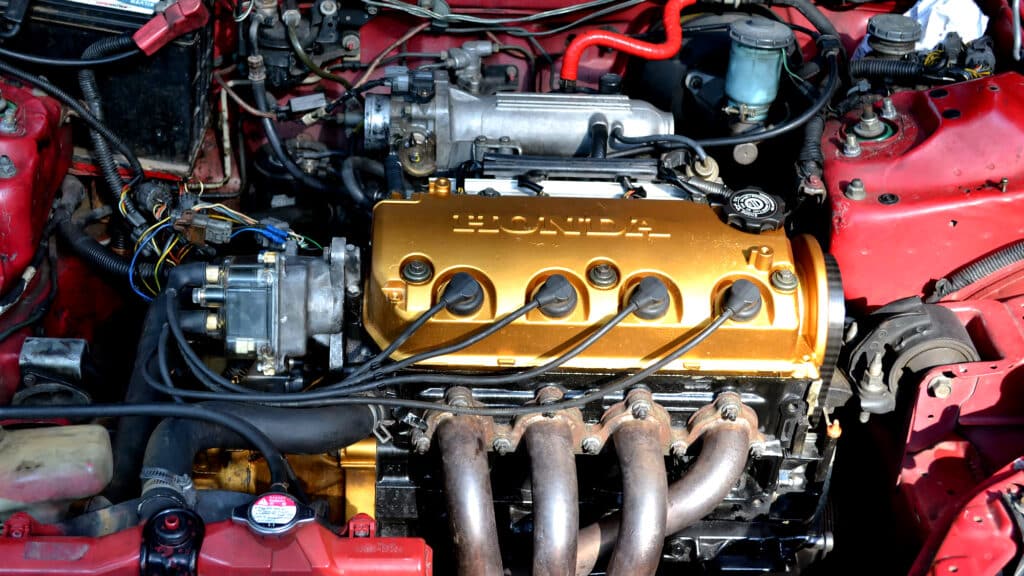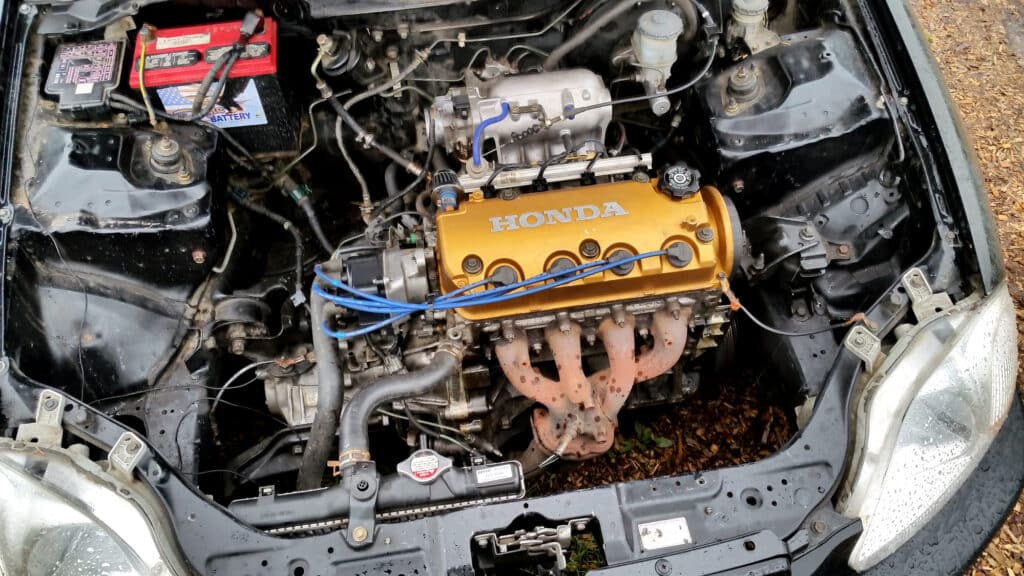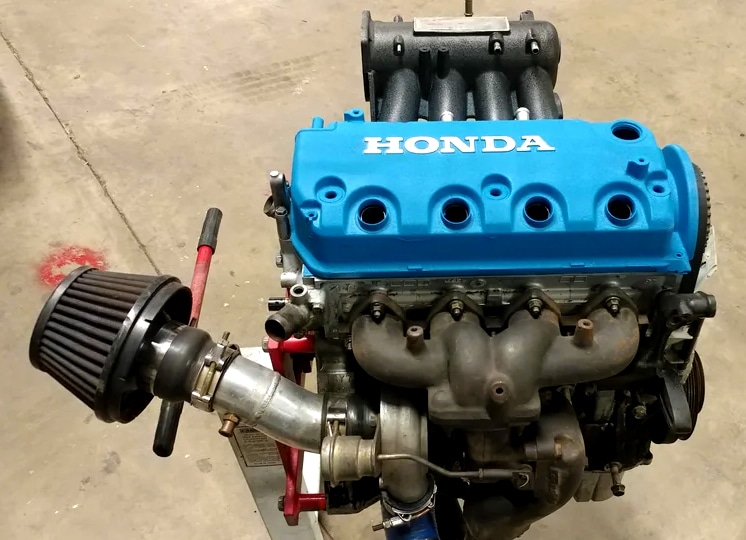The D16Y7 engine, as its name implies, is part of Honda’s D-series engine lineup. The SOHC 1.6-liter, four-cylinder, non-VTEC unit was in production from 1996 to 2000.
It can be found in Honda Civics from that era, most notably the EJ and EK variants, as well as the targa-top Del Sol.
It’s a very reliable motor that’s affordable to run, making it perfect for an everyday car. However, it does have a few issues, and it certainly lacks in the power department.
In this article, we’ll take a closer look at the Honda D16Y7’s strengths and weaknesses. We’ll also cover the best mods if you want to squeeze more power from it, and discuss whether it’s worth doing so.
Honda D16Y7 Specs

- Displacement: 1,590 cc
- Layout: 1.6 L L4 SOHC 16v
- Power: 106 hp at 6,200 rpm
- Torque: 103 lb-ft at 4,600 rpm
- Compression ratio: 9.4:1
- Firing order: 1-3-4-2
- Fuel system: OBD2 MPFI
- Cylinder bore: 75.0 mm (2.95″)
- Piston stroke: 90.0 mm (3.54″)
The Honda D16Y7 is found in the 1996-2000 CX, DX, and LX Honda Civic trims, 1996-1997 Civic Coupé LSi, as well as the 1996-1997 Honda Del Sol base model.
Honda’s D16Y7 motor is a SOHC (single overhead cam) design, meaning the cylinder head only has one camshaft operating the valves. There are 4 valves per cylinder, 2 on the intake side, and 2 for the exhaust.
The D16Y7 unit does not have Honda’s VTEC (Variable Valve Timing and Lift Electronic Control) system.
However, being a part of the modular D-series family, parts are interchangeable, meaning it can be converted to VTEC using the Y8 or Z6 head.
Z6 heads are a bit beefier and rev higher, so if you have to choose between the two, we recommend installing a D16Z6 head.
Honda D16Y7 Common Problems

While the D16Y7 engine is known to be a fairly reliable unit, you need to remember that it’s getting pretty old nowadays, so some problems are to be expected.
Timing belt tensioner failure is the most serious problem and can cause serious engine damage. If you intend to extract more power, make sure you inspect it first.
Another potential issue that should be dealt with before tuning is the head gasket. A blown head gasket will cause coolant to mix with the engine oil, risking major engine damage. At the very least, buy an engine compression tester and check each cylinder.
The Honda D16Y7 engine is also prone to oil leaks. There are a few areas to check, namely the front crankshaft seal, timing cover, and valve cover gasket.
O2 sensor, distributor, and idle air control valve failure are also well-known problems. It should be noted that most cars of this age will experience issues, so this isn’t something that’s unique to the D16Y7 motor.
Tuning the Honda D16Y7 Engine

There are two routes to choose from if you want more power from your Honda D16Y7 engine. You can either keep it naturally aspirated for a reliable yet fun daily driver, or fit a turbo kit for all-out power.
Both routes can be as cheap or expensive as you want, it all depends on the parts you decide to use.
If you’re wondering how much hp a D16Y7 can handle, the honest answer is that it really depends on how much you’re prepared to spend.
That being said, enthusiasts have built 400+ hp turbocharged monsters on a shoestring budget using off-brand parts. Just keep in mind that cheaper isn’t always better.
Naturally Aspirated D16Y7

The Honda D16Y7 isn’t the ideal base for a naturally aspirated build. Going with the basics, an intake, headers, and a cat-back or axle back exhaust will make it breathe a bit better and give it a nicer sound.
If you don’t have money to spend, or you’re not mechanically inclined, it’s not really worth taking it further than that.
If you do have some mechanical skills, a Mini-Me swap is the way to go. Basically, it involves replacing the head with one from the D16Z6 or D16Y8, both of which are SOHC VTEC units, and you’ll instantly have 20 hp more.
There’s a bit more to it than just plug and play, but that would require a separate guide to explain.
From there, it’s possible to fit a larger throttle body, a better intake manifold, a performance cam, new valve springs and retainers, an adjustable cam gear, and swap the ECU for an OBD1 unit so you can tune it.
At this point, you’re looking at 150+ whp, depending on the parts you decide to go with. This places the humble D-series firmly in stock B-series territory, which would make for a very fun daily driver or trackday tool.
D16Y7 Forced Induction

It’s possible to go with a cheap, off-brand D16Y7 turbo kit and run it as-is. Those looking to extract as much power as possible should install some other modifications as well.
How much boost the D16Y7 can handle? That’s probably one of the most common questions when it comes to turbocharging, but there’s no single answer to that, as it depends on the turbocharger.
200-220 whp is about the maximum the stock engine can handle. Beyond that, you’ll need forged rods, Suzuki Vitara pistons, ARP head bolts, and the list gets longer the more power you want.
Since the D16 engines are so cheap, some gearheads decide to throw caution to the wind and just fit a turbo kit, then wind up the boost to the max.
We definitely don’t recommend doing that, but it’s a possibility. If you want maximum power combined with reliability, a properly built turbocharged D-series engine can produce 400+ whp, but it certainly won’t be cheap.
Concluding Thoughts
The Honda D16Y7 engine is perfect if you’re looking for a reliable daily driver that returns decent MPG and is cheap to insure.
While the D-series certainly has the potential to make serious power, it often costs more than it’s worth to get it to that level.
If your car has this 1.6L l4 SOHC 16v unit, and, for some reason, you’re unable to do a B16 or K20 engine swap, it may be worth considering the modifications mentioned above.
That said, a better option would probably be to just buy another, more powerful car. Which is your favorite Honda D engine? Let us know by leaving a comment below!
If you enjoyed reading this article, do share it with your friends on social media or on your favorite car forums!

